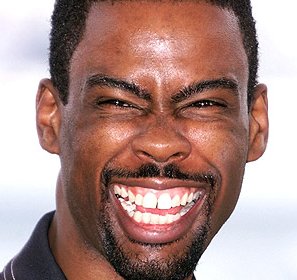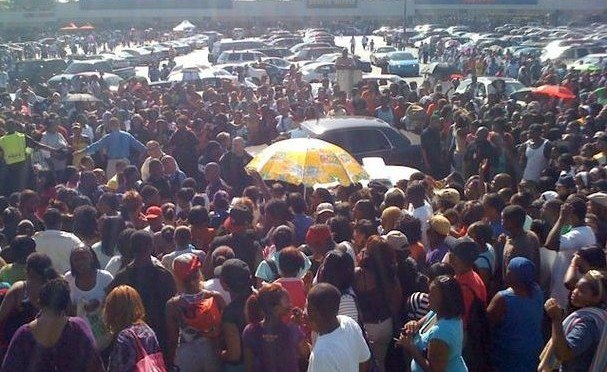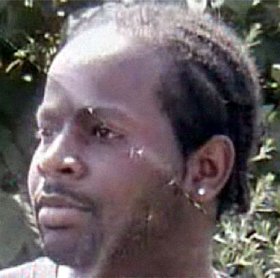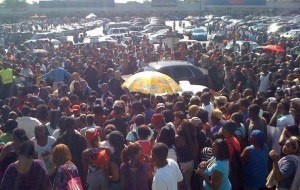 30,000 line up for housing vouchers, some get rowdy:
30,000 line up for housing vouchers, some get rowdy:
Thirty thousand people showed up to receive Section 8 housing applications in East Point Wednesday, suffering through hours in the hot sun, angry flare-ups in the crowd and lots of frustration and confusion for a chance to receive a government-subsidized apartment.
The Housing Choice Voucher Program, called Section 8, subsidized the rents of low-income families living in apartments and houses that are privately owned. The federal program makes up the difference in rent that the poor can afford and the fair market value for each area.
The same media pundits who pathologize the Tea Party as violent and greedy and too White won’t be saying anything like that about this seething crowd of self-interested blacks, or how desperate they are to be delivered from their own kind.
Hanna Rosin’s American Murder Mystery tries to bury the answer to the “mystery” of the relationship between Section 8 and crime in paragraphs of tedious, turgid obfuscation. I’ll try here to cut through it.
Memphis has always been associated with some amount of violence. But why has Elvis’s hometown turned into America’s new South Bronx? [Lieutenant Doug] Barnes thinks he knows one big part of the answer, as does the city’s chief of police. A handful of local criminologists and social scientists think they can explain it, too. But it’s a dismal answer, one that city leaders have made clear they don’t want to hear. It’s an answer that offers up racial stereotypes to fearful whites in a city trying to move beyond racial tensions. Ultimately, it reaches beyond crime and implicates one of the most ambitious antipoverty programs of recent decades.
Note that neither Rosin or any of the people she quotes in this article, except perhaps the police, sympathize with the “fearful” Whites. Never once is the terrible cost to Whites mentioned. The main reason this is a “dismal” tale “they don’t want to hear” is that Section 8 has not helped non-Whites as much as they would have liked.
[University of Memphis Criminologist Richard] Janikowski might not have managed to pinpoint the cause of this pattern if he hadn’t been married to Phyllis Betts, a housing expert at the University of Memphis. Betts and Janikowski have two dogs, three cats, and no kids; they both tend to bring their work home with them. Betts had been evaluating the impact of one of the city government’s most ambitious initiatives: the demolition of the city’s public-housing projects, as part of a nationwide experiment to free the poor from the destructive effects of concentrated poverty. Memphis demolished its first project in 1997. The city gave former residents federal “Section8” rent-subsidy vouchers and encouraged them to move out to new neighborhoods. Two more waves of demolition followed over the next nine years, dispersing tens of thousands of poor people into the wider metro community.
About six months ago, they decided to put a hunch to the test. Janikowski merged his computer map of crime patterns with Betts’s map of Section8 rentals. Where Janikowski saw a bunny rabbit, Betts saw a sideways horseshoe (“He has a better imagination,” she said). Otherwise, the match was near-perfect. On the merged map, dense violent-crime areas are shaded dark blue, and Section8 addresses are represented by little red dots. All of the dark-blue areas are covered in little red dots, like bursts of gunfire. The rest of the city has almost no dots.
Betts remembers her discomfort as she looked at the map. The couple had been musing about the connection for months, but they were amazed—and deflated—to see how perfectly the two data sets fit together. She knew right away that this would be a “hard thing to say or write.” Nobody in the antipoverty community and nobody in city leadership was going to welcome the news that the noble experiment that they’d been engaged in for the past decade had been bringing the city down, in ways they’d never expected. But the connection was too obvious to ignore, and Betts and Janikowski figured that the same thing must be happening all around the country.
After decades of pathologizing millions of “fearful” Whites who objected to Section 8 and other government-imposed racial integration programs as morally and/or mentally defective, statistics show that our fears were justified. But that isn’t what Betts is “discomforted” or “deflated” about. What’s such a “hard thing to say or write” is that crime and poverty and blackness are connected.
Betts’s office is filled with books about knocking down the projects, an effort considered by fellow housing experts to be their great contribution to the civil-rights movement. The work grew out of a long history of white resistance to blacks’ moving out of what used to be called the ghetto. During much of the 20th century, white people used bombs and mobs to keep black people out of their neighborhoods. In 1949 in Chicago, a rumor that a black family was moving onto a white block prompted a riot that grew to 10,000 people in four days. “Americans had been treating blacks seeking housing outside the ghetto not much better than … [the] cook treated the dog who sought a crust of bread,” wrote the ACLU lawyer and fair-housing advocate Alexander Polikoff in his book Waiting for Gautreaux.
Polikoff is a hero to Betts and many of her colleagues. In August 1966, he filed two related class-action suits against the Chicago Housing Authority and the U.S. Department of Housing and Urban Development, on behalf of a woman named Dorothy Gautreaux and other tenants. Gautreaux wanted to leave the ghetto, but the CHA offered housing only in neighborhoods just like hers. Polikoff became notorious in the Chicago suburbs; one community group, he wrote, awarded him a gold-plated pooper-scooper “to clean up all the shit” he wanted to bring into the neighborhood. A decade later, he argued the case before the Supreme Court and won. Legal scholars today often compare the case’s significance to that of Brown v. Board of Education of Topeka.
It could be argued that the genocidal monsters who imposed this nightmare might have done so out of ignorance. At least as first. For those who continue to support it now there is no explanation but anti-White animus. Here we can see that animus in the depiction of White violence, decades past, in the same tired pathologizing terms. Why else ignore the self-defensive motivations of Whites long since proven justified, and why present White violence as worse than the more brutal, more enduring, and more widespread black violence perpetrated since?
A well-known Gautreaux study, released in 1991, showed spectacular results. The sociologist James Rosenbaum at Northwestern University had followed 114 families who had moved to the suburbs, although only 68 were still cooperating by the time he released the study. Compared to former public-housing residents who’d stayed within the city, the suburban dwellers were four times as likely to finish high school, twice as likely to attend college, and more likely to be employed. Newsweek called the program “stunning” and said the project renewed “one’s faith in the struggle.” In a glowing segment, a 60 Minutes reporter asked one Gautreaux boy what he wanted to be when he grew up. “I haven’t really made up my mind,” the boy said. “Construction worker, architect, anesthesiologist.” Another child’s mother declared it “the end of poverty” for her family.
In 1992, 7-year-old Dantrell Davis from the Cabrini-Green project was walking to school, holding his mother’s hand, when a stray bullet killed him. The hand-holding detail seemed to stir the city in a way that none of the other murder stories coming out of the high-rises ever had. “Tear down the high rises,” demanded an editorial in the Chicago Tribune, while that boy’s image “burns in our civic memory.”
If replacing housing projects with vouchers had achieved its main goal—infusing the poor with middle-class habits—then higher crime rates might be a price worth paying. But today, social scientists looking back on the whole grand experiment are apt to use words like baffling and disappointing. A large federal-government study conducted over the past decade—a follow-up to the highly positive, highly publicized Gautreaux study of 1991—produced results that were “puzzling,” said Susan Popkin of the Urban Institute.
More fitting words for “the whole grand experiment”, as well as those who aid and abet it: mendacious, fraudulent, genocidal. Criminal.
The best Popkin can say is: “It has not lived up to its promise. It has not lifted people out of poverty, it has not made them self-sufficient, and it has left a lot of people behind.”
For Popkin, Rosin, Janikowski, Betts, Polikoff, Rosenbaum, The Atlantic, Newsweek, 60 Minutes, and their fellow travellers, what’s really important is that non-Whites haven’t benefitted enough. No apologies to the victims of their violence. No refunds for those who have been forced to fund their own genocide.
The article concludes with a talmudic shrug, magically transferring the blame to Whites:
It’s difficult to contemplate solutions to this problem when so few politicians, civil servants, and academics seem willing to talk about it—or even to admit that it exists. Janikowski and Betts are in an awkward position. They are both white academics in a city with many African American political leaders. Neither of them is a Memphis native. And they know that their research will fuel the usual NIMBY paranoia about poor people destroying the suburbs. “We don’t want Memphis to be seen as the armpit of the nation,” Betts said. “And we don’t want to be the ones responsible for framing these issues in the wrong way.”
Pathologizing Whites as “paranoid” is how these issues have long been framed.
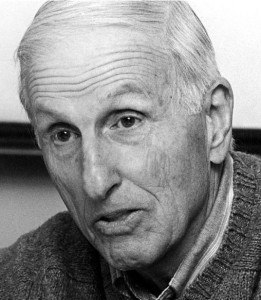 Alexander Polikoff’s Gautreaux Proposal, written in Nov/Dec 2004, puts it this way:
Alexander Polikoff’s Gautreaux Proposal, written in Nov/Dec 2004, puts it this way:
Ending black ghettos wouldn’t end anti-black attitudes any more than ending Jewish ghettos ended anti-semitism. But it is not easy to find anything in American society that matches the black ghetto for its poisoning effect on attitudes, values and conduct.
Sixty years ago, Gunnar Myrdal wrote: “White prejudice and discrimination keep the Negro low in standards of living, health, education, manners and morals. This, in its turn, gives support to white prejudice.” Decades later, sociologist Elijah Anderson’s studies of a ghetto and an adjacent non-ghetto neighborhood led him to conclude: “The public awareness is color-coded. White skin denotes civility, law-abidingness, and trustworthiness, while black skin is strongly associated with poverty, crime, incivility, and distrust.” In American society at large, most whites act like the ones Anderson studied — their public awareness is also color-coded, and they steer clear of poor blacks and keep them in their ghettos. Predictable ghetto behavior then intensifies whites’ sense of danger, validates their color-coding and drives their conduct.
Sixty years ago this kind of anti-White guilt-tripping might have seemed brave or iconoclastic. Today the government and blacks are the ones inflicting violence on Whites. We can see that “prejudice and discrimination” don’t cause black poverty, crime, and incivility. Blacks know it. They prove it by suffering through hours in the hot sun to get an application to be put on a waiting list so they can escape and live amongst Whites. We know that they bring their poverty, crime, and incivility with them.
Knowing all this, we are justified in distrusting, opposing, and even despising the professional grievance mongers who are complicit in it. Their sympathies for blacks, even if sincere, don’t excuse the harm their twisted thinking has caused Whites.
UPDATE 12 Aug 2010: More on Janikowski and Betts via James Edwards.
Couple’s findings link crime in Memphis to Section 8 voucher renters » The Commercial Appeal, by Fredric Koeppel, 11 Sept 2008:
In other words, crime follows poverty wherever it goes.
“Well, that’s a bit of a simplification,” said Janikowski, associate professor in the Department of Criminology and Criminal Justice at the University of Memphis and director of the Center for Community Criminology and Research, “though that’s the way our studies have been interpreted. Crime and poverty are inextricably linked, there’s no question, but it’s not that poverty causes crime. Poverty creates a contact point that exacerbates all sorts of stresses on people. It’s not that there’s any one cause. It’s a confluence of stresses.”
In other words, crime and poverty and other stresses follow blacks wherever they go. There is no question that Section 8 has shifted crime and poverty to neighborhoods previously unafflicted by such problems. There is no question this has exacerbated all sorts of stresses on the people in these predominantly White neighborhoods, impoverishing them and making them miserable enough to leave, if they can. Clearly Janikowski isn’t talking about these stresses. The attempt here is to obfuscate the link between blackness and crime and poverty. And it is done even while the problems are deliberately simplified and explicitly linked to Whiteness, which is consistently offered both as the only cause for the problems and as the only obstacle to ending them.
As outsiders to Memphis and as a couple committed to public service, Betts and Janikowski feel keenly the ambivalence of their position. They have, after all, and almost inadvertently, delivered the bad news that the Section 8 housing program in Memphis is not working. They are white college professors, trained in academic research; most residents of public housing are poor and black and uneducated.
The “bad news” here is not that Section 8 has been foisted on Whites who don’t want it, justified by historic anti-White stereotypes and libels, and when it is empirically demonstrated not to lift blacks out of poverty and crime, that this too is blamed on Whites. That’s just how the “bad news” (i.e. blackness is linked to crime and poverty) has been framed. It is classic blame-the-victim apologia from fulminating hypocrites who make their living sniffing out and pathologizing stereotypes, libels, and blaming-the-victim. The bad news for Whites is that Section 8 exists – that there’s no question we, as a group, pay for it and are harmed by it.
At that meeting [where Betts and Janikowski presented their findings to the Memphis City Council] was Robert Lipscomb, director of the city’s Housing and Community Development division. He remains among their most vocal detractors.
Lipscomb is black. He unequivocally describes Section 8 participants as “the victims of crime, not the cause”.
“Well, Robert has his viewpoint,” said Janikowski. “Maybe we should have put it differently, not emphasized vouchers so much. We have gotten local feedback that has been much more positive, but people have been saying racist things.”
“There’s been so much follow-up at the national level from people who have no background at the local level,” said Betts. “The feeling that we share ideas with right-wing bloggers is devastating.”
Janikowski regrets that he didn’t try sooner and harder to frame the problems even more simply and explicitly as being caused by “racists” and “right-wing bloggers”. The fact is that Whites at the local level have been deliberately harmed by the anti-White/pro-black policies. These policies are advocated by dishonest snake-oil salesmen operating at the national level, who are provided megaphones by media and academia and courts to broadcast their poisonous ideas.

